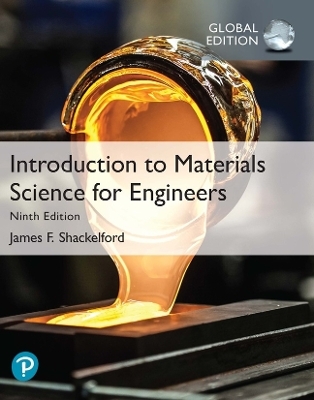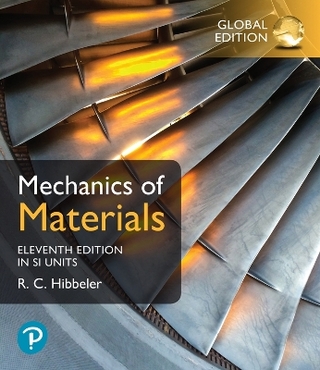
Introduction to Materials Science for Engineers plus Pearson Mastering Engineering with Pearson eText (Package)
Pearson Education Limited
978-1-292-44103-0 (ISBN)
Introduction to Materials Science for Engineers providesbalanced, current treatment of the full spectrum of engineering materials,covering all the physical properties, applications and relevant propertiesassociated with engineering materials. It explores all of the major categoriesof materials while also offering detailed examinations of a wide range of newmaterials with high-tech applications.
James F. Shackelford has BS and MS degrees in Ceramic Engineering from the University of Washington and a Ph.D. in Materials Science and Engineering from the University of California, Berkeley. Following a postdoctoral fellowship at McMaster University in Canada, he joined the University of California, Davis, where he is currently Distinguished Professor Emeritus in the Department of Materials Science and Engineering. For many years, he served as the Associate Dean for Undergraduate Studies in the College of Engineering and later as the Director of the University Honors Program that serves students from a wide spectrum of majors. Dr. Shackelford also served as Associate Director for Education for the National Science Foundation (NSF)-funded Center for Biophotonics Science and Technology (CBST) and as Faculty Assistant to the Director of the McClellan Nuclear Research Center (MNRC) of UC Davis. He teaches and conducts research in the structural characterization and processing of materials, focusing on glasses and biomaterials. His current focus in teaching is doing so through online technologies. A member of the American Ceramic Society and ASM International, he was named a Fellow of the American Ceramic Society in 1992, was named a Fellow of ASM International in2011, and received the Outstanding Educator Award of the American Ceramic Society in 1996 and the Albert Easton White Distinguished Teacher Award from ASM International in 2019. In 2003, he received a Distinguished Teaching Award from the Academic Senate of the University of California, Davis. In 2012, he received the Outstanding Teaching Award of the College of Engineering at UC Davis, and, in 2014, received an Outstanding Service Award from UC Davis Extension. In 2016, Professor Shackelford received the Inaugural Award for Outstanding Contributions to Materials Education at the North American Materials Education Symposium (NAMES) held at the University of California, Berkeley. He has published over 150 archived papers and books including Introduction to Materials Science for Engineers now in its 9th Edition and which has been translated into Chinese, German, Italian, Japanese, Korean, Portuguese, and Spanish.
Materials for Engineering
1.1 The Material World
1.2 Materials Science and Engineering
1.3 Six Materials That Changed Your World
STEEL BRIDGES—INTRODUCING METALS
TRANSPARENT OXIDES—INTRODUCING CERAMICS
SMARTPHONES AND TABLETS—INTRODUCING GLASSES
NYLON PARACHUTES—INTRODUCING POLYMERS
KEVLAR®-REINFORCED TIRES—INTRODUCINGCOMPOSITES
SILICON CHIPS—INTRODUCING SEMICONDUCTORS
1.4 Processing and Selecting Materials
1.5 Looking at Materials by Powers of Ten
PARTI: The Fundamentals
Atomic Bonding
2.1 Atomic Structure
2.2 The Ionic Bond
COORDINATION NUMBER
2.3 The Covalent Bond
2.4 The Metallic Bond
2.5 The Secondary, or van der Waals, Bond
2.6 Materials—The Bonding Classification
Crystalline Structure—Perfection
3.1 Seven Systems and Fourteen Lattices
3.2 Metal Structures
3.3 Ceramic Structures
Crystal Defects and Noncrystalline Structure—Imperfection
4.1 The Solid Solution—Chemical Imperfection
4.2 Point Defects—Zero-Dimensional Imperfections
4.3 Linear Defects, or Dislocations—One-Dimensional Imperfections
4.4 Planar Defects—Two-Dimensional Imperfections
4.5 Noncrystalline Solids—Three-Dimensional Imperfections
Diffusion
5.1 Thermally Activated Processes
5.2 Thermal Production of Point Defects
5.3 Point Defects and Solid-State Diffusion
5.4 Steady-State Diffusion
5.5 Alternate Diffusion Paths
Mechanical Behavior
6.1 Stress Versus Strain
METALS
CERAMICS AND GLASSES
POLYMERS
6.2 Elastic Deformation
6.3 Plastic Deformation
6.4 Hardness
6.5 Creep and Stress Relaxation
6.6 Viscoelastic Deformation
INORGANIC GLASSES
ORGANIC POLYMERS
ELASTOMERS
Thermal Behavior
7.1 Heat Capacity
7.2 Thermal Expansion
7.3 Thermal Conductivity
7.4 Thermal Shock
Failure Analysis and Prevention
8.1 Impact Energy
8.2 Fracture Toughness
8.3 Fatigue
8.4 Nondestructive Testing
8.5 Failure Analysis and Prevention
Phase Diagrams—Equilibrium Microstructural Development
9.1 The Phase Rule
9.2 The Phase Diagram
COMPLETE SOLID SOLUTION EUTECTIC DIAGRAM WITH NO SOLID SOLUTION
EUTECTIC DIAGRAM WITH LIMITED SOLID SOLUTION
EUTECTOID DIAGRAM
PERITECTIC DIAGRAM
GENERAL BINARY DIAGRAMS
9.3 The Lever Rule
9.4 Microstructural Development During Slow Cooling
Time—The Third Dimension
10.1 Time—The Third Dimension
10.2 The TTT Diagram
DIFFUSIONAL TRANSFORMATIONS
DIFFUSIONLESS (MARTENSITIC) TRANSFORMATIONS
HEAT TREATMENT OF STEEL
10.3 Hardenability
10.4 Precipitation Hardening
10.5 Annealing
COLD WORK
RECOVERY
RECRYSTALLIZATION
GRAIN GROWTH
10.6 The Kinetics of Phase Transformations for Nonmetals
PART II: Materials and Their Applications
Structural Materials—Metals, Ceramics, and Glasses
11.1 Metals
FERROUS ALLOYS
NONFERROUS ALLOYS
11.2 Ceramics and Glasses
CERAMICS—CRYSTALLINE MATERIALS
GLASSES—NONCRYSTALLINE MATERIALS
GLASS-CERAMICS
11.3 Processing the Structural Materials
PROCESSING OF METALS
PROCESSING OF CERAMICS AND GLASSES
Structural Materials—Polymers and Composites
Polymers
POLYMERIZATION
STRUCTURAL FEATURES OF POLYMERS
THERMOPLASTIC POLYMERS
THERMOSETTING POLYMERS
ADDITIVES
12.2 Composites
FIBER-REINFORCED COMPOSITES
AGGREGATE COMPOSITES
PROPERTY AVERAGING
MECHANICAL PROPERTIES OF COMPOSITES
12.3 Processing the Structural Materials
PROCESSING OF POLYMERS
PROCESSING OF COMPOSITES
Electronic Materials
13.1 Charge Carriers and Conduction
13.2 Energy Levels and Energy Bands
13.3 Conductors
THERMOCOUPLES
SUPERCONDUCTORS
13.4 Insulators
FERROELECTRICS
PIEZOELECTRICS
13.5 Semiconductors
INTRINSIC, ELEMENTAL SEMICONDUCTORS
EXTRINSIC, ELEMENTAL SEMICONDUCTORS
COMPOUND SEMICONDUCTORS
PROCESSING OF SEMICONDUCTORS
SEMICONDUCTOR DEVICES
13.6 Composites
13.7 Electrical Classification of Materials
Optical and Magnetic Materials
14.1 Optical Materials
OPTICAL PROPERTIES
OPTICAL SYSTEMS AND DEVICES
14.2 Magnetic Materials
FERROMAGNETISM
FERRIMAGNETISM
METALLIC MAGNETS
CERAMIC MAGNETS
Materials in Engineering Design
15.1 Material Properties—Engineering Design Parameters
15.2 Selection of Structural Materials—Case Studies
MATERIALS FOR HIP- AND KNEE-JOINT REPLACEMENT
METAL SUBSTITUTION WITH COMPOSITES
15.3 Selection of Electronic, Optical, and Magnetic Materials—Case Studies
LIGHT-EMITTING DIODE
GLASS FOR SMART PHONE AND TABLET TOUCHSCREENS
AMORPHOUS METAL FOR ELECTRIC-POWERDISTRIBUTION
15.4 Materials and Our Environment
ENVIRONMENTAL DEGRADATION OF MATERIALS
ENVIRONMENTAL ASPECTS OF DESIGN RECYCLING AND REUSE
APPENDIX1: Physical and Chemical Data for the Elements
APPENDIX 2: Atomic and Ionic Radii of the Elements
APPENDIX 3: Constants and Conversion Factors and the Periodic Table of Elements
APPENDIX 4: Properties of the Structural Materials
APPENDIX 5: Properties of the Electronic, Optical, and Magnetic Materials
APPENDIX 6: Glossary Answers to Practice Problems (PP) and Odd-Numbered Problems Index
| Erscheint lt. Verlag | 15.2.2024 |
|---|---|
| Verlagsort | Harlow |
| Sprache | englisch |
| Maße | 200 x 250 mm |
| Gewicht | 1279 g |
| Themenwelt | Technik ► Maschinenbau |
| ISBN-10 | 1-292-44103-8 / 1292441038 |
| ISBN-13 | 978-1-292-44103-0 / 9781292441030 |
| Zustand | Neuware |
| Haben Sie eine Frage zum Produkt? |
aus dem Bereich
